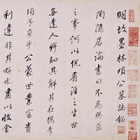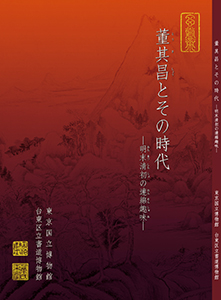Asian Gallery (Toyokan) Room 8
January 2, 2017 (Mon) - February 26, 2017 (Sun)
Dong Qichang (1555–1636), a renowned literati from the Ming dynasty, was a high-ranking bureaucrat who excelled in calligraphy and painting. In calligraphy, he first studied works of Yan Zhenqing from Tang, tracing back to works from Wu and Jin dynasties including Wang Xizhi. He was against the stylized calligraphy of the time, and seeing light and plain styles as ideal, he added dynamic elements of unbroken lines. As for painting, after learning the four masters of the late Yuan dynasty, he traced the tradition back to Dong Yuan, extending to diverse styles of Song and Yuan dynasties. He inherited and followed the tradition of literati painting, and at the same time, painted in radical brushstrokes as a pioneer of eccentric painters.
Dong Qichang also had distinguished insights in theories and appraisals of painting and calligraphy. His essay Hua Chanshi Suibi is known for his deep comprehensions and ideas.
The transition from Ming to Qing dynasty was not merely a change of regime, but a major historical incident where the Han Chinese lost their supremacy to the Manchus, a different ethnic group. Therefore, ideals of painting and calligraphy advocated by Dong Qichang were heavily reflected on works of the turbulent time from the end of Ming to the beginning of Qing. Connected calligraphic styles were a perfect form to entrust despondent spirits. Furthermore, because the Qing emperors Kangxi and Qianlong favored his works, Dong Qichang continued to be influential over the 300-year long Qing dynasty.
On this 380th memorial year of Dong Qichang, this 14th collaborative project with the Taito City Calligraphy Museum features Dong Qichang who significantly influenced his following generations, together with works by artists who were active before and after him. We hope to present an intriguing world of Dong Qichang through exhibitions at the two museums.


